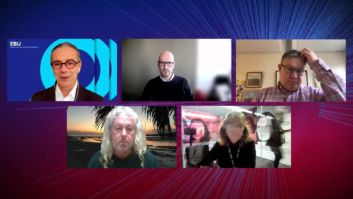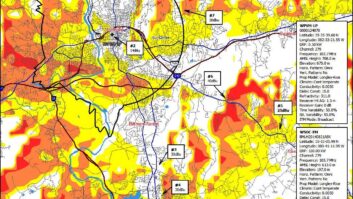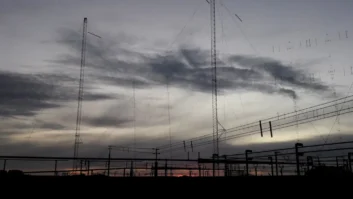Digital Radio Update – June 7, 2006
Jun 7, 2006 10:38 AM, By Mark Krieger, CBT
Stay up to date on the latest IBOC news, business and technology information with the twice-monthly newsletter from Radio magazine.
Index:
- CEA to Introduce New Media Interface Standard
- PRI Undertakes PSD Implementation Project
- FCC has Mediaflo on Pause
- XM Withdraws App to Acquire WRS Frequencies
- XM Receivers Recalled
- IBOC by State: Georgia
- An Introduction to the New Language Surrounding HD Radio
- BE Tapped for WV Public Radio HD Conversions
- Ibiquity Enlists Sanyo in Asian OEM Efforts
- To receive these articles twice a month in your e-mail, subscribe to the Digital Radio Update – Insight to IBOC e-newsletter. Click here to subscribe.NewsCEA to Introduce New Media Interface Standard
A working group in the Standards Development and International Programs division of the Consumer Electronics Association (CEA) is putting the final touches on a new connection standard to facilitate the transfer of digital audio and video media between portable and fixed consumer media platforms.The new standard, now known as CEA-2017, includes electrical, mechanical and logical specifications for a standard connector suitable for docking and interconnection for audio and video content for nomadic devices with playback capabilities. This includes cradling and controlling nomadic devices in an in-vehicle and in-home environment, connecting peripheral devices and connecting two or more nomadic devices.The standard would allow a new level of compatibility between personal media players and in-vehicle or in-home systems, regardless of manufacturer. A CEA spokesperson said that the working group (R6WG15) is still working on details of the new standard, but hopes to complete its mission in time to publish before the end of 2006.PRI Undertakes PSD Implementation Project
Public Radio International (PRI) is enlisting public radio stations to join in a consortium that seeks to map standardized and cost-effective procedures for implementing and exploiting HD Radio’s program service data (PSD) streaming text capability. The project is being funded with grants from the Corporation for Public Broadcasting (CPB). Some of the project’s goals include: - Developing a standardized implementation guide or “cookbook,” that will make adoption easier, faster and cheaper for public radio stations.
- Generating a set of voluntary standards for how the PSD capacity is to be used. Unlike some commercial stations that operate under a single music format, public radio stations tend to block program with diverse combinations of music, news and talk content. This raises questions about what kind of data might be presented beyond simple listings of song title and artist. Furthermore, many public radio stations operate with a patchwork of network and locally originated programming, further necessitating a need for standardized types of data fields.
- Leveraging the knowledge base of existing PSD users in the public radio ranks.
While the question of how to format PSD may seem mundane at first, project organizers suggest that a considerable amount of creativity and care will be required to maximize the informational value of the two 64-character fields currently provisioned in first generation HD Radio receivers. Project organizers note that the BBC, faced with a similar task when implementing Eureka 147 DAB rollouts in the UK, developed techniques for limited character text message construction to a level approaching that of an art form. - BusinessFCC has Mediaflo on Pause
A quandary over possible adjacent-channel interference to legacy analog TV licensees may place a planned October roll-out of Qualcomm’s Mediaflo digital mobile media distribution network in the United States on hold, according to a recent report in Broadcasting and Cable magazine.Qualcomm, which has reportedly invested over $800 million in the proprietary technology, is licensing to operate on refarmed spectrum purchased at federal auction, formerly belonging to TV broadcasters on channel 55 (716MHz to 722MHz). In its push to clear a path for the new technology, the company has even offered to pay some broadcasters in key markets to vacate their analog spectrum more than two years ahead of the April 2009 cut-off date established by Congress.Because the company’s technology is independent of cellular networks but complements CDMA2000(R) 1X, 1xEV-DO and WCDMA cellular network data and voice services, its use of transmitter sites in urban markets has raised issues regarding potential adjacent channel interference to existing analog TV license holders on UHF channels 54 and 56.Qualcomm says Mediaflo technology will support at least 20 streaming channels of QVGA (240×320 pixels) quality video at 30 frames per second, 10 stereo audio channels (HE AAC+ parametric stereo) and more than 800 minutes of stored, short-format video clips referred to as “clipcasting.”The FCC has yet to rule on what interference specifications will be imposed on the new service for the duration of its coexistence with analog TV signals.XM Withdraws App to Acquire WRS Frequencies
In a move roundly applauded by the U.S. radio broadcasting industry, XM Satellite Radio has terminated its agreement to acquire the assets of WCS Wireless. Both the NAB and XM-rival Sirius Satellite Radio, two opponents who filed petitions with the FCC opposing the plan, heralded the announcement.WCS Wireless, which holds unbuilt wireless spectrum adjacent to the L-band spectrum allocated for satellite radio throughout the United States, was seen as an attractive target for XM. Critics of the acquisition alleged that XM planned to use the WRS allocations to build a de facto localized terrestrial network to complement its national satellite service.According to the principals, the acquisition agreement initially announced on July 13, 2005, had languished without required government approvals, despite both parties’ best efforts to obtain them on a timely basis. Termination of the agreement was described as a logical step in freeing WCS to pursue other suitors for its licenses.XM Receivers Recalled
Manufacturers of some XM Satellite Radio receivers, including a popular model from Audiovox, have voluntarily pulled their product from dealer shelves as FCC and independent tests suggest that the FM modulators in the devices exceed FCC specification for bandwidth and emission limits.A number of listeners to stations in the lower non-commercial portion of the FM band, where most RF modulators operate, have complained of having their receivers “captured” by the modulators in XM radios onboard nearby vehicles. Some satellite receiver owners have even boasted of the strength of certain modulators in online user forums, with anecdotal reports that some can be heard across an entire mall parking lot.While some non-commercial broadcasters licensed in the frequency range in question suggest that modulators be required to operate below 88.1MHz to prevent interference to licensed users, some experts say that out-of-band operation would not comply with current Part 15 rules for low power broadcast devices.The FCC is studying sample receivers carefully, but has yet to take any official action beyond notifying manufacturers of initial test results.IBOC Across AmericaIBOC by State: Georgia
Ibiquity has a list of stations that have licensed HD Radio technology and notes those that are on the air now. IBOC by state will look at various states and list the stations that are making the transition.Market Station HD1 HD2 HD3 Owner Atlanta WABE 90.1 FM Nws/Tlk/Cls – – Atlanta Board of Education Atlanta WAEC 860 AM Religion – – Beasley Broadcast Group Atlanta WALR 104.1 FM R&B Oldies Adult Hip Hop – Cox Radio Atlanta WAMJ 102.5 FM R&B Oldies – – Radio One Atlanta WBTS 95.5 FM CHR/Rhymc Top 40 – Cox Radio Atlanta WBZY 105.3 FM Modern Rock New Alternative – Clear Channel Radio Atlanta WCLK 91.9 FM Jazz – – Clark College Atlanta WHAT 107.9 FM Urban AC – – Radio One Atlanta WKHX 101.5 FM Country – – ABC Radio Atlanta WKLS 96.1 FM Clsc Rock AAA – Clear Channel Radio Atlanta WLTM 94.9 FM Soft AC Oldies – Clear Channel Radio Atlanta WMLB 1160 AM Variety – – Atlanta Area Broadcasting Atlanta WNNX 99.7 FM Altve/NwRck – – Susquehanna Radio Atlanta WSB 98.5 FM Soft AC Soft Standards – Cox Radio Atlanta WSRV 97.1 FM Clsc Hits News/Talk – Cox Radio Atlanta WSTR 94.1 FM Top 40 – – Jefferson-Pilot Atlanta WVEE 103.3 FM Urban Neo-Soul / Urban AC – CBS Radio Atlanta WVWA 96.7 FM Spanish Regional Mexican – Clear Channel Radio Atlanta WWVA 105.7 FM Spanish Hispanic AC – Clear Channel Radio Atlanta WWWE 1100 AM Span/Chrst – – Beasley Broadcast Group Atlanta WWWQ 100.5 FM CHR – – Susquehanna Radio Atlanta WYAY 106.7 FM Country – – ABC Radio Augusta WGAC 580 AM News/Talk – – Beasley Broadcast Group Augusta WHHD 98.3 FM Adult Top 40 WGAC 580 – Beasley Broadcast Group Augusta WRDW 1630 AM Sports – – Beasley Broadcast Group Glennville WOAH 106.3 FM Urban – – Broadcast ExecutivesHD Radio TerminologyThe new language of HD Radiorobustness: The ability of a logical channel to withstand channel impairments such as noise, interference and fading. There are 11 distinct levels of robustness designed into Layer 1 of the FM air interface. One of the three characterization parameters.transfer: A measure of the data throughput through a logical channel. One of the three characterization parameters.Eye on IBOCBE Tapped for WV Public Radio HD Conversions
Broadcast Electronics (BE) has received orders for nine HD Radio transmission systems and two booster systems from West Virginia Public Broadcasting, which operates the statewide West Virginia Public Radio service.The project, scheduled for early fall of this year, includes transmission and signal generation equipment for turnkey HD Radio conversion of West Virginia Public Radio’s entire complement of stations.”The main reason we wanted to go HD Radio–and do it quickly–is because West Virginia is a topographically difficult broadcast state,” said Bill Acker, director of broadcasting and technology for West Virginia Public Broadcasting. “Early studies indicate that converting to digital will reduce or eliminate reflective noise from signals bouncing off hills.”West Virginia Public Broadcasting also purchased two BE digital FM exciters that will be phase-synchronized with primary broadcast signals for use as gap fillers in RF shadow zones occurring in some low-lying areas.Ibiquity Enlists Sanyo in Asian OEM Efforts
Ibiquity Digital has inked a deal with Sanyo Trading Co. to assist in building its relationship with Japanese Automakers. Sanyo already represents a number of U.S. and European automotive parts suppliers selling to Asian auto manufacturers.”The growth of HD Radio in the U.S. and other markets has gained tremendous momentum in the past year,” said Jeff Jury, Ibiquity chief operating officer. “Automotive manufacturers across Asia, Europe and the U.S. are rolling out HD Radio. Our relationship with the Sanyo Trading Co. is a key component in our commitment to support HD Radio on a worldwide basis.”To date, only upscale European carmaker BMW is offering HD Radio as a factory option in its 5, 6 and 7 Series automobiles. But Ibiquity claims it currently has commitments from eight additional manufacturers to include receivers in as many as 40 models over the next several years.Ibiquity says Sanyo Trading will supplement the company’s in-house marketing efforts by providing in-country support to major OEMs deploying HD Radio in vehicles.Sanyo Trading is a privately held company with operations in Tokyo, Osaka, Nagoya (Japan), New York, Detroit, Cincinnati, Amsterdam, Netherlands, Shanghai, Guangzhou, Tianjin in China and Bangkok, Thailand.












